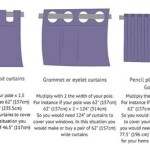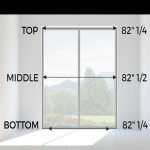What Size Shower Curtain For A Stall Shower?
Selecting the appropriate shower curtain size is a crucial aspect of bathroom design and functionality, particularly when dealing with a stall shower. A correctly sized shower curtain prevents water from escaping the enclosure, maintains bathroom hygiene, and contributes to the overall aesthetic appeal of the space. Understanding the typical dimensions of stall showers and shower curtains, along with factors influencing the ideal fit, is essential for making an informed purchasing decision. This article will explore these factors to provide a comprehensive guide to choosing the right size shower curtain for a stall shower.
A stall shower, also known as a shower stall or standing shower, is generally characterized by its compact size. It features a confined enclosure designed for showering only, without a bathtub. These showers are frequently found in smaller bathrooms, guest bathrooms, or as secondary shower options within larger residences. Because of their limited dimensions, stall showers require specifically sized shower curtains to ensure adequate water containment and prevent issues such as mold growth and water damage to the surrounding bathroom area.
The primary functions of a shower curtain extend beyond mere decoration. A shower curtain acts as a barrier to prevent water spray from escaping the shower enclosure during use. This protection safeguards the bathroom floor, walls, and fixtures from water damage, reducing the risk of issues like wood rot, paint peeling, and the development of mold and mildew. Furthermore, a shower curtain provides a degree of privacy for the user while showering. The material and design of the curtain can also impact the overall aesthetic appearance of the bathroom, contributing to the desired style and ambiance.
Understanding Standard Stall Shower Dimensions
To accurately determine the required shower curtain size, it's necessary to understand the standard dimensions of a stall shower. While variations exist, stall showers generally adhere to a few common size ranges. The most common stall shower dimensions are approximately 36 inches wide by 36 inches deep, or 36 inches wide by 48 inches deep. These dimensions represent the interior floor space of the shower enclosure itself. Some stall showers may be slightly larger or smaller than these standard measurements, so it's always best to accurately measure the specific shower enclosure before purchasing a shower curtain.
Measuring a stall shower for a shower curtain involves a few key steps. First, measure the width of the shower opening from one wall to the other. This measurement will determine the minimum width required for the shower curtain. Second, measure the height from the shower rod to the floor. This measurement will determine the length of the shower curtain. When measuring, it's important to consider the shower rod's position. A shower curtain should ideally hang a few inches above the floor to allow for proper ventilation and prevent mold growth. Typically, a gap of 2-4 inches between the bottom of the curtain and the floor is recommended.
Factors contributing to variations in stall shower dimensions include the age of the home, the design of the bathroom, and any custom modifications that may have been made. Older homes may have smaller stall showers than newer constructions. Bathrooms designed for accessibility may also have larger or differently shaped stall showers to accommodate wheelchairs or other mobility aids. Custom-built showers may deviate significantly from standard dimensions, requiring careful measurement and potentially a custom-sized shower curtain.
Ideal Shower Curtain Sizes for Stall Showers
Given the typical dimensions of stall showers, the most common shower curtain size is 54 inches wide by 78 inches long. This size is specifically designed to fit the narrower width of a stall shower while providing adequate length to prevent water from escaping. However, it's important to note that this is a general recommendation, and the ideal size may vary depending on the specific measurements of the shower enclosure and the position of the shower rod.
When determining the ideal shower curtain length, consider the following factors. If the shower rod is positioned higher than average, a longer shower curtain may be necessary to reach the desired distance from the floor. Conversely, if the shower rod is positioned lower, a standard-length shower curtain may be too long and require hemming or adjustment. It's also important to consider the shower curtain's material. Heavier materials may need slightly more length to allow for proper draping and prevent them from clinging to the shower floor.
Alternatives to standard-sized shower curtains include custom-made curtains and adaptable options. Custom-made shower curtains can be created to perfectly fit unique shower dimensions, offering a precise and tailored solution. Adaptable options, such as shower curtain liners that can be easily cut or trimmed, provide greater flexibility in achieving the desired fit. These options can be particularly beneficial for showers with unusual dimensions or configurations.
Materials and Features to Consider
The choice of shower curtain material significantly impacts its performance and durability. Common materials include vinyl, polyester, and fabric blends. Vinyl shower curtains are water-resistant, easy to clean, and relatively inexpensive. However, they can sometimes have a chemical odor and may not be as aesthetically appealing as other options. Polyester shower curtains are more durable, wrinkle-resistant, and can be machine-washed. They also offer a wider range of designs and colors. Fabric blends combine the benefits of different materials, such as cotton and polyester, to create a shower curtain that is both durable and aesthetically pleasing.
Features that enhance the functionality and lifespan of a shower curtain include reinforced grommets, weighted hems, and water-repellent coatings. Reinforced grommets prevent tearing and ensure that the shower curtain hangs securely from the shower rod. Weighted hems help to keep the shower curtain in place and prevent it from billowing outward during use. Water-repellent coatings help to prevent water from soaking into the fabric, reducing the risk of mold and mildew growth.
Beyond the basic function of water containment, shower curtains contribute significantly to the bathroom's aesthetic. Available in a wide array of colors, patterns, and textures, shower curtains can complement or contrast with the existing bathroom decor. Light colors can brighten up a small bathroom, while bold patterns can add visual interest. The choice of shower curtain should reflect the overall style and ambiance of the bathroom, creating a cohesive and visually appealing space.
In summary, choosing the correct shower curtain size for a stall shower involves carefully considering the dimensions of the shower enclosure, the position of the shower rod, and the desired aesthetic. Accurately measuring the shower and understanding the available options are essential steps in selecting a shower curtain that provides effective water containment, enhances the bathroom's appearance, and promotes a hygienic environment.

Liba Fabric Shower Curtain White Heavy Duty Water Repellent Soft Cloth Hotel Style Curtains

Most Popular Shower Curtain Sizes Measuring Tips

Evideco French Home Goods 72 In L X 48 W Small Stall White Shower Curtain Narrow Size 8 Matching Rings 1210100 The

Choose The Correct Size Shower Curtain

Gray Stall Shower Curtain Half Size Polyester 8 Rings 48 W X 72 H

Hookless Hbh43lit01sx White Stall Size Litchfield Shower Curtain With Matching Flat Flex On Rings And Weighted Corner Magnets 42 X 74

Small Single Shower Curtain Liner For Stall Size 36x72 8g Heavy Duty Peva Clear

Interdesign Poly Waterproof Stall Size Shower Curtain Liner In White 14662 The Home

Small Stall Shower Curtain 36 X 72 Brown Marble Half Size Modern Abstract Narrow For Bathroom Decor Inch Fabric

Stall Size Medium Weight Peva Shower Liner Clear Threshold 100 Waterproof Grommet Top Design
See Also








